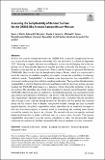| dc.contributor.author | Walsh, Kevin J. | |
| dc.contributor.author | Bierhaus, Edward B. | |
| dc.contributor.author | Lauretta, Dante S. | |
| dc.contributor.author | Nolan, Michael C. | |
| dc.contributor.author | Ballouz, Ronald-Louis | |
| dc.contributor.author | Bennett, Carina A. | |
| dc.contributor.author | Jawin, Erica R. | |
| dc.contributor.author | Barnouin, Olivier S. | |
| dc.contributor.author | Berry, Kevin | |
| dc.contributor.author | Burke, Keara N. | |
| dc.contributor.author | Brodbeck, Bella | |
| dc.contributor.author | Burns, Rich | |
| dc.contributor.author | Clark, Benton C. | |
| dc.contributor.author | Clark, Beth E. | |
| dc.contributor.author | Cambioni, Saverio | |
| dc.date.accessioned | 2022-04-25T13:49:25Z | |
| dc.date.available | 2022-04-25T13:49:25Z | |
| dc.date.issued | 2022-04-19 | |
| dc.identifier.uri | https://hdl.handle.net/1721.1/142039 | |
| dc.description.abstract | Abstract
NASA’s first asteroid sample return mission, OSIRIS-REx, collected a sample from the surface of near-Earth asteroid Bennu in October 2020 and will deliver it to Earth in September 2023. Selecting a sample collection site on Bennu’s surface was challenging due to the surprising lack of large ponded deposits of regolith particles exclusively fine enough (
≤
2
cm
$\leq2~\text{cm}$
diameter) to be ingested by the spacecraft’s Touch-and-Go Sample Acquisition Mechanism (TAGSAM). Here we describe the Sampleability Map of Bennu, which was constructed to aid in the selection of candidate sampling sites and to estimate the probability of collecting sufficient sample. “Sampleability” is a numeric score that expresses the compatibility of a given area’s surface properties with the sampling mechanism. The algorithm that determines sampleability is a best fit functional form to an extensive suite of laboratory testing outcomes tracking the TAGSAM performance as a function of four observable properties of the target asteroid. The algorithm and testing were designed to measure and subsequently predict TAGSAM collection amounts as a function of the minimum particle size, maximum particle size, particle size frequency distribution, and the tilt of the TAGSAM head off the surface. The sampleability algorithm operated at two general scales, consistent with the resolution and coverage of data collected during the mission. The first scale was global and evaluated nearly the full surface. Due to Bennu’s unexpected boulder coverage and lack of ponded regolith deposits, the global sampleability efforts relied heavily on additional strategies to find and characterize regions of interest based on quantifying and avoiding areas heavily covered by material too large to be collected. The second scale was site-specific and used higher-resolution data to predict collected mass at a given contact location. The rigorous sampleability assessments gave the mission confidence to select the best possible sample collection site and directly enabled successful collection of hundreds of grams of material. | en_US |
| dc.publisher | Springer Netherlands | en_US |
| dc.relation.isversionof | https://doi.org/10.1007/s11214-022-00887-2 | en_US |
| dc.rights | Creative Commons Attribution | en_US |
| dc.rights.uri | https://creativecommons.org/licenses/by/4.0/ | en_US |
| dc.source | Springer Netherlands | en_US |
| dc.title | Assessing the Sampleability of Bennu’s Surface for the OSIRIS-REx Asteroid Sample Return Mission | en_US |
| dc.type | Article | en_US |
| dc.identifier.citation | Space Science Reviews. 2022 Apr 19;218(4):20 | en_US |
| dc.contributor.department | Massachusetts Institute of Technology. Department of Earth, Atmospheric, and Planetary Sciences | |
| dc.identifier.mitlicense | PUBLISHER_CC | |
| dc.eprint.version | Final published version | en_US |
| dc.type.uri | http://purl.org/eprint/type/JournalArticle | en_US |
| eprint.status | http://purl.org/eprint/status/PeerReviewed | en_US |
| dc.date.updated | 2022-04-24T03:26:17Z | |
| dc.language.rfc3066 | en | |
| dc.rights.holder | The Author(s) | |
| dspace.embargo.terms | N | |
| dspace.date.submission | 2022-04-24T03:26:17Z | |
| mit.license | PUBLISHER_CC | |
| mit.metadata.status | Authority Work and Publication Information Needed | en_US |
